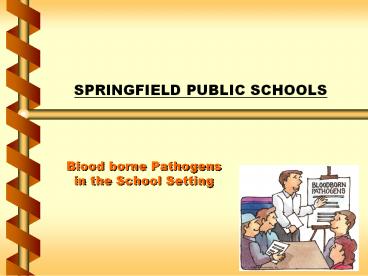Blood borne Pathogens in the School Setting - PowerPoint PPT Presentation
Title:
Blood borne Pathogens in the School Setting
Description:
SPRINGFIELD PUBLIC SCHOOLS Blood borne Pathogens in the School Setting Who is Affected? Occupational exposure - results from doing one s job JOB CLASSIFICATIONS ... – PowerPoint PPT presentation
Number of Views:1168
Avg rating:3.0/5.0
Title: Blood borne Pathogens in the School Setting
1
Blood borne Pathogens in the School Setting
SPRINGFIELD PUBLIC SCHOOLS
2
Who is Affected?
- Occupational exposure - results from doing ones
job - JOB CLASSIFICATIONS
- Coaches
- Special Ed Teachers
- Custodians
- Health Assistants
- Paraprofessionals
- Phys Ed Staff
- Bus Drivers
- Potentially infectious materials
- Blood
- Urine, vomit, or other body fluids
- Especially when blood is present
3
Epidemiology symptoms of blood borne diseases
- Blood borne pathogens
- Infectious organisms present in human blood that
cause disease - - Hepatitis B virus (HBV)
- Symptoms fatigue, stomach pain, loss of
appetite, nausea - Acute Hepatitis, Chronic Carriers, or Unaffected
- Not easily killed outside body, can survive up to
7 days in dried blood - Vaccine Preventable
4
Epidemiology symptoms of blood borne diseases
(contd)
- - Human immunodeficiency virus (HIV)
- Attacks immune system
- Not vaccine preventable
- Virus is killed easily outside the body
- Symptoms weakness, fever, nausea, sore throat,
can lead to AIDS. - - Hepatitis C
- May be asymptomatic for 20-30 years
- Symptoms Include fatigue, weight loss, nausea,
darkened urine, jaundice, stomach pain - No vaccine
- 75-85 with positive test develop chronic
hepatitis-----gt liver disease
5
WHAT IS A BBP EXPOSURE?
- The Infectious body fluid must enter the
bloodstream to cause infection. - It can enter through these routes
- Eyes
- Mouth
- Mucous membrane
- Non-intact skin
- Piercing of skin or mucous membranes (bites,
needle stick)
6
When can Exposure Occur?
- First aid situations
- Accidents or injuries in
- sports, on playground,
- in shops, or in health
- offices.
- Other workplace situations
- Body Fluid or Blood cleanup
- Broken Science glassware
- Handling Sharps
- Dealing with violent behavior
7
What Can I Do to Protect Myself?
- Take advantage of Hepatitis B Vaccination
- Before performing clean up or providing first aid
PUT ON GLOVES! Always think of yourself first. - When administering first aid, instruct injured
person in self-management - Always practice universal precautions
- Clean-up involving blood requires special
procedures - Most Important - Wash your Hands!!!
8
Handwashing is Important!
- Locations
- Portable facilities
- Sanitized Hand Wipes
9
How Should Contaminated Items be Disposed Of?
- Regulated vs. Non-regulated Waste
- Materials saturated to the point of dripping
blood or including body tissue or parts. - Most of the waste generated in a school is
non-regulated waste and can be placed in regular
trash
10
Disposal Continued
- Place contaminated gloves and absorbent material
in a bag and place in lined trash container. - Do not place red Biohazard bags in regular
trash. - Follow proper sanitization procedures for
contaminated surfaces or objects.
11
Disposal Continued
- Sharps Containers
- Located in each Health Office
- For contaminated sharps such as needles, razor
blades, glass - Regulated Waste, must be properly disposed of as
Biohazard Waste.
12
Hepatitis B Vaccine
- Available free of charge
- Prevention - for employees who have risk of
occupational exposure. - Employees eligible for the vaccine are Special
Education Teachers, Coaches, Custodians, Health
Assistants, Paraprofessionals, PE Staff.
13
Hepatitis B Vaccine
- Hepatitis B Vaccine A series of three shots
taking a total of 6 months to complete - Employees refusing the vaccine must sign a
declination form
14
Exposure incident response
- Potential exposure incidents involving
fluid-to-fluid contact - Eyes, mouth, mucous membranes
- non-intact skin
- parenteral contact (puncture, bite)
- Flush the exposed area with water immediately
- Report the incident to your supervisor and/or
District Nurse!
15
BBP Summary
- Implementing a Successful BBP Program includes
all of the following - Written Program
- Annual Employee Training
- Hepatitis B vaccination
- Record keeping
- Engineering and work practice controls
- Personal protective equipment
- Housekeeping, cleaning schedule
- Procedures for evaluating an exposure incident
- Post-exposure evaluation and follow-up
16
The End
- Questions?
- Contact Elen Stark _at_ x1167

